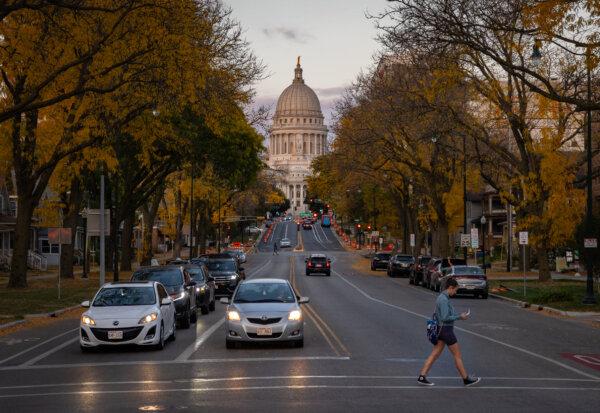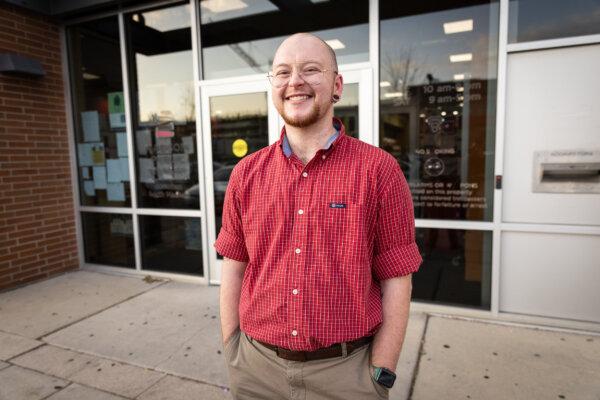Madison, Waukesha, Brown Deer, and Johnson Creek sound off as state struggles with a slow voter management system.
As Wisconsin’s version of early voting got underway, The Epoch Times spoke to voters from a wide range of places and perspectives: small towns, Milwaukee suburbs, conservative Waukesha, and liberal Madison.
Voter turnout on day one of in-person absentee voting stood at 97,436—more than 17,000 votes higher than in 2020, during the COVID-19 pandemic response.
Some clerks dealt with technical issues on Oct. 22 when trying to print labels for absentee ballot envelopes. That process depended on a voter registration and election management platform called WisVote.
“Today’s system lag was purely related to demands on the WisVote system due to high turnout,” the Wisconsin Elections Commission (WEC) wrote in a press release on the problem stating that it had been resolved.
However, the delays cropped up again the following day.
“WEC staff learned Wednesday that the system delay is not just affecting WisVote label printing—it appears to also be affecting some non-election related state systems as well. High levels of in-person absentee voting do still appear to be compounding the issue,” the agency wrote in an Oct. 23 press release.
The statement noted that clerks can hand-write labels instead of printing them, potentially offering some relief as Wisconsinites wait in voting lines.
From Waukesha to Madison, citizens made it clear to The Epoch Times that they were eager have an impact in the battleground state’s popular vote—one where an unexpectedly tight race between incumbent Sen. Tammy Baldwin (D-Wisc.) and Eric Hovde may also tip the balance of the Senate.
Brown Deer and Waukesha
Early voting was taking place at the Brown Deer Village Hall on the morning of Oct. 22. By just after 9 a.m., officials estimated that 30 to 40 people had already walked through to cast absentee ballots in person.
Brown Deer lies across the Milwaukee River from River Hills, a much wealthier suburb of Milwaukee, and just south of heavily Republican Ozaukee County. It also directly borders Milwaukee, a bastion for Democrats.
Historically, Brown Deer has had a blue tinge. In 2016, for example, wards 1 and 2 delivered almost 69 percent of their votes to Hillary Clinton. She got over 58 percent in wards 3 and 4.
It’s also more than 30 percent African American, which is considered a high percentage for the communities around Wisconsin’s biggest city.
Carl Evans and his wife, Dollora Greene-Evans, were among the black Wisconsinites proud to cast their ballots in person. Vice President Kamala Harris had won their support.

Carl Evans recalled that he had once voted for the Republican presidential nominee Richard Nixon.
“Never again,” he said, expressing a sense of betrayal over how Nixon handled the Vietnam War.
“I had three brothers who served,” he said.
“There’s a little passion there,” Dollora observed of her husband’s response.
About 28 miles away, the people of Waukesha showed passion in their own way. A line to vote stretched outside Waukesha City Hall.
Waukesha’s more than 70,000 inhabitants are a small chunk of Waukesha County, population 407,000. President Joe Biden’s 38.8 percent of the vote there in 2020 was a strong performance for Democrats in the exurban GOP heartland.
Trump’s running mate, Sen. JD Vance (R-Ohio), came to Waukesha County just days before early voting was set to begin.
“I know we’ve got a lot of Catholics for Trump. I see the signs here,” he said.

Sam, a Catholic Trump voter who did not want to share his last name, was in the line on Oct. 22. He wore a “Make America Great Again” hat and a shirt referencing conservative commentator Dan Bongino. He agreed that Waukeha has a very Catholic flavor.
Sam worries about how a possible future Harris administration would handle the border, foreign relations, and spending.
“If you’re spending more money on other countries, no wonder there’s deterioration here in our programs,” Sam said.
He’s also concerned about the long-range financial viability of Social Security, a program that both candidates have claimed they will save.
“I think there have to be reforms there,” Sam said.

Two other Trump voters, David and Bruna Iljazi, stood near the front of the line. Bruna was pushing their son, Anzil, in a baby carriage.
David said the economy tops his concerns this election season. “That’s the most important thing to look for is making sure your family is okay,” he said.
Bruna, an immigrant from Albania, agreed that people come to America to make a good life for themselves. “And [if] you work, you do,” she said.
Dane County and Jefferson County
About halfway across the state from Waukesha County is Dane County. Home to the state capital, Madison, and the University of Wisconsin’s flagship campus, it’s a mainstay for Democrats. In 2020, Trump got less than 23 percent of Dane County’s vote.

The voting statistics from the counties also underscore some key differences between Democrat- and Republican-leaning places when it comes to voting habits.
While Dane County’s population is 41 percent higher than Waukesha County’s, it only had four percent more in-person absentee voting on Oct. 23, according to WEC. Yet, it had returned 45 percent more absentee ballots overall, reflecting greater use of mail-in absentee ballots.
While Waukesha saw a visit from Vance, Madison on Oct. 22 saw a visit from Harris’s running mate, Minnesota Gov. Tim Walz, who was joined by former President Barack Obama and other heavyweight state Democrats, along with “West Wing” actor Bradley Whitford.
“Wisconsin, God, I love you. You are going to lead the way,” the actor and Madison native told the crowd.

It was possible for Madisonians to vote after the afternoon Obama/Walz rally ended. That was what Pam Wilkinson did at a local library.
“It was circled for a really, really, really long time,” the yoga instructor and rock-climbing coach said of the voting site on the first date for early voting. “I was jumping up and down all day, just waiting for my roommate to get home.”
Her roommate, nurse Pat Harris, stood alongside her. The two had cast their ballots for the other Harris. Wilkinson was inspired to support Harris, in part, by abortion rights.
She was excited for another reason: she was about to go rock climbing for the first time in years following a serious accident.
Abortion rights also helped motivate Dolyn Salm, a Harris voter and pharmacy resident hailing from Fond Du Lac. But the Harris voter declined to name his top issues when asked.

“They all kind of work together,” Salm said.
Stuart was a voter who knew what were his top issues. He lauded Harris’s proposals for an increased child tax credit and down payment support for first time homebuyers.
In his mid-twenties, Stuart works for Epic Systems, a healthcare software company and major economic force in Madison.

Dane County seemed a world away from Jefferson County, the next county over, and another rural Republican hotspot. Biden scored just 41 percent of its vote in 2020.
For one thing, while there are early voting sites aplenty across Madison, options were more limited in some little hamlets.
In Lake Mills, with a population of 6,211, would-be early voters must schedule an appointment with the local clerk. That clerk, Robin Untz, reported unusually high turnouts to The Epoch Times.
“Normally, I have approximately 10 or less requesting this service during other elections—presidential elections always have more requests—but the number of appointments I have now is the highest I can remember,” she wrote in an email.
As of Oct. 22, she had 43 appointments total, 26 of which were for the first day of early voting.
On Oct. 23, the second day of early voting, people were trickling in and out of an early voting site in Johnson Creek. Not much more than half Lake Mills’ size, it’s the next town over on Interstate 94. Johnson Creek’s clerk, Elissa Friedl, told The Epoch Times by email that 70 voters cast early ballots on Oct. 22. Like other places in Wisconsin, they had minor hiccups with label printing that day.
“Although we have backup plans in case the WisVote system is unavailable or slower than yesterday, no alternate plans had to be used,” she wrote.

Autumn leaves tumbled through the streets, past the local Lutheran church, which was hosting a pancake breakfast. Philip and Connie Sierlecki had been there before they dropped by for early voting.
Phillip, a retired postal worker, entered and exited the site on crutches: multiple sclerosis. “That only gets worse,” he said.
But the disease didn’t stop him from casting his early ballot for Trump.
“We don’t vote Democrat or Republican. We just vote what we want,” said his wife, who also voted Trump. She’s on medical leave from serving as head cook in a local public school.
“That’s how I met her. She put lunches in the mailbox, and I’d get ‘em every day,” Philip said.
“My neighbor said, ‘You have to come meet the mailman,’” she recalled.
As the Sierleckis spoke, Marty Braunschweig and his friend Susan Vogel walked past. “We voted Trump,” Braunschweig said.
Braunschweig, an older gentleman, had retired from a very Wisconsin flavor of work. He made malt for beer.
Braunschweig’s top issues could be summed up in a few words: “law and order” and “the border.”
“I don’t like Kamala’s policies. I like Trump’s,” he said.
Madison, Waukesha, Brown Deer, and Johnson Creek all have a say in Wisconsin’s presidential election. The strength of every little town, and a few big cities, could make the difference come January.

